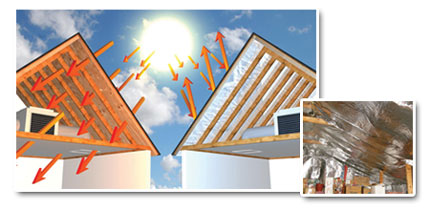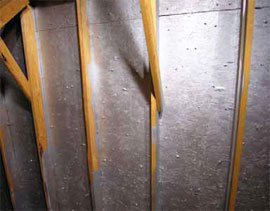In Business Since | License #
In Business Since | License #


Ever jump in your car after it's been sitting in the sun for an hour or so? Whew! It's REALLY hot. Those dark leather seats can make you jump up when you sit down. How does your car's interior get hotter than the outside air temperature? It's because of the sun's radiant energy-solar heat that keeps building up in the small interior space of your car.
On a sunny summer day, the air in your attic can get just as hot as the air in your car. When attic air temperatures climb to 120 degrees and higher, your house heats up too, causing your air conditioning system to work much harder than it should. You end up using a lot more electricity and paying a lot more to stay comfortable. Most people think an attic fan is the answer, but Dr. Energy Saver can educate and help you determine the right solution.

The foil radiant barrier under the windshield reflects the sun's heat.
Spread out beneath your car's windshield, a foil-faced sun shade is a radiant barrier that does a good job of reflecting solar heat so that your car won't get too hot. The radiant barriers used in attics work just like these shiny car shades. During hot weather, an attic radiant barrier can reflect as much as 97% of the sun's heat back toward the outside, reducing your heat gain and lowering air-conditioning costs. In the wintertime, the reflective effect works in reverse, helping to bounce heat back toward your living space.
An attic radiant barrier can cut air conditioning expenses by 10% or more. You can expect the most savings if you live in warmer climates where AC loads are high.
Installing a radiant barrier reflective insulation in your attic is a smart energy-saving investment if you live in a warm climate. But don't rule out this upgrade if you live farther north, especially if you have ductwork and other HVAC equipment (like furnaces or air conditioning units) in your attic. Dr. Energy Saver can install a reflective radiant barrier against the bottom edges of your rafters to help improve cooling efficiency in the summer and heating efficiency in the winter.
The most commonly used reflective radiant barrier for attics is a thin plastic sheet with a reflective finish on one or both sides. Another type of radiant barrier looks just like the bubble wrap used to protect delicate items during shipping, but with a shiny coating. The small air bubbles add insulation value. Sheet-type reflective radiant barriers like these can be installed simply by laying them on top of the attic insulation, but they will lose some of their effectiveness over time as dust builds up and reduces the barrier's reflectivity.

While not as effective at reflecting heat as sheet-type barriers, this may be the most practical method in some attics.
If you use some of your attic space for storage, have Dr. Energy Saver install a radiant barrier against the rafters. The radiant barrier will protect your stored items from extreme temperatures, and the reflective surface will amplify your attic lighting.
In some attics, there are too many obstructions that get in the way of installing a sheet-type reflective radiant barrier. Access to certain parts of the attic can also be difficult. In these cases, Dr. Energy Saver may recommend a spray-on radiant barrier. This shiny coating can be applied to the underside of your roof sheathing. While it's not as effective at reflecting heat as a sheet-type barrier, this may be the most practical way for you to achieve extra energy savings.
If radiant barriers are the right option to save energy and better control your home's environment, your Dr. Energy Saver dealer will let you know! Schedule a home energy audit to discover your home's energy inefficiencies and learn more about all of our proven solutions.
Looking for a price? Get a no cost, no obligation free estimate.